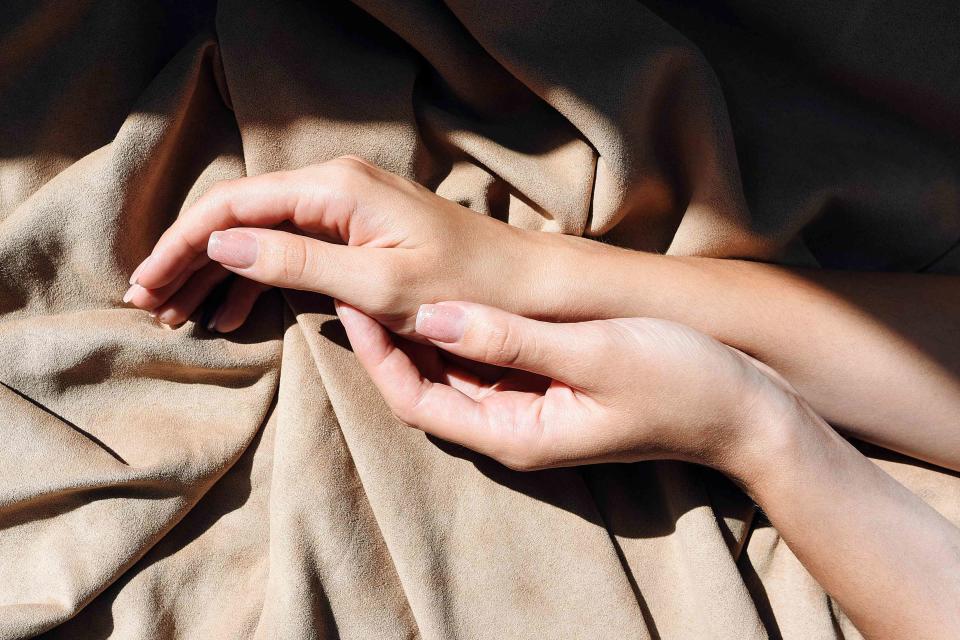This Is the Real Reason Your Nails Are Peeling
The ultimate guide to preventing and treating pesky peeling nails.

Getty Images
We buff, shape, file, and polish our nails to make them look gorgeous. And while healthy-looking nails sit high on most of our beauty wishlists, that constant maintenance can contribute to weak, peeling nails.
Not only could they be a sign of damage, but peeling nails could also indicate something happening internally — since the nails often reflect your health. Ahead, we break down everything there is to know about weak, peeling, and brittle nails with the help of a few experts.
Related:6 Expert-Approved Ways to Strengthen Damaged Nails
Why Nails Peel
Peeling nails are common and can occur from genetics, aging, product use, overexposure to water and chemicals, psoriasis, fungus, medications, vitamin deficiencies, and viral infections. (Whew.)
Sporting long, fake nails, which rely on harsh glues to adhere to the natural nails, can also lead to damage. Amy Ling Lin, CEO and founder of New York nail studio Sundays, says that the application process of acrylic nails, plus their heavy weight, can suffocate the nails and weaken them, leading to peeling. "Similarly, improper removal of dip or gel nail polish can provoke the nails to thin and peel," she adds. "Buffing is relatively safe, but excessively doing it can induce peeling."
Although preventing the nails from coming into contact with water is challenging, it's another frequent source of flaking nails. Lin explains that when the nails absorb water and swell (from exposure for long periods), the bonds between the nail layers weaken, causing the nails to peel easily. Harsh cleaning products have the same effect.
On the other hand, overly dry nails can also peel, especially when they are buffed and drilled down during manicures. And for some people that experience peeling nails, a diet lacking calcium and iron may be to blame. Likewise, thyroid issues and disorders can also impact nail health.
Nail damage may seem to happen overnight, but double-board certified dermatologist Karan Lal, MD, says that the visible effects usually take a few weeks to months after a trigger manifests. "For example, an active viral infection may not cause peeling right away, but it may materialize weeks after the infection resolves."
How to Prevent Peeling Nails
For starters, Dr. Lal recommends following a healthy diet. Upping your iron, calcium, and biotin intake through eggs, avocados, leafy greens, and lean protein sources can aid in strengthening weak nails. Add a multivitamin to supplement any missing vitamins or nutrients for an extra layer of protection.
Using the wrong nail products can also instigate peeling. For example, Dana Stern, MD, a board-certified dermatologist and founder of nail-care brand Dr. Dana, says cardboard emery boards generate microscopic tears at the tip of the nail, which can lead to peeling. Buffing and acetone are also offenders. "Acetone dissolves intercellular lipids and damages intercellular adhesion, which makes nails more fragile," she explains. Instead, opt for acetone-free polishes to retain moisture within the nail while still doing their job.
If you want to nip peeling nails in the bud, take a break from wearing nail polish — since it cannot adhere properly to the nails and will likely roll off them. That also means temporarily breaking up with gel and dip manicures and leaving nail extensions, acrylics and tips. Polish-free nails also give them a chance to breathe.
Related:Nail Slugging Is the Secret to Healthy, Strong Nails
The Best Ways to Rehab Peeling Nails
Once you’ve identified the root cause of your peeling nails, devise an at-home plan of attack that nurses them back to health.
Wearing gloves is the best way to minimize contact between nails, water, and chemicals. "A study showed that gloves that create a lot of moisture can exacerbate the issue for those with brittle nails," Dr. Stern says. "So wearing cotton gloves under rubber ones is recommended when doing wet work, like washing dishes or cleaning."
Regularly applying hand cream, like Sundays Super Hydrating Hand Cream, can also help keep the nails hydrated to prevent peeling. Similarly, cuticle oils can work their magic to rehydrate weak nails. Nail hardeners are also beneficial. "They act as a shield and prevent the nails from interacting with irritants, chemicals, and water, which can thin them out," Dr. Lal says.
And, just like skin requires regular exfoliation to stay healthy, nails do too. "If you look at a peeling nail under a microscope, the nail cells are detached, lifted, and separating, which causes them to peel and split and for polish not to go on smoothly," Dr. Stern explains. Try a nail system like Dr. Dana Nail Renewal System, which contains glycolic acid to exfoliate the nails correctly.
Finally, give your nails time to rest, recover and regrow. "The nails take time to rehab," Dr. Lal shares. "Since they grow about three millimeters per month, it could take one to two months to see them recover." But it's well worth it.
Related:How To Get Healthy Nails After Acrylics
For more InStyle news, make sure to sign up for our newsletter!
Read the original article on InStyle.

